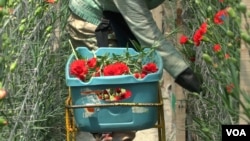Artificial lakes in flower fields surrounding the savannah of the Colombian capital, Bogotá, have become a crucial refuge for hundreds of bird species that once depended on natural wetlands, which have been drastically reduced.
These bodies of water, originally designed to irrigate flowers, have gradually been transformed into spaces where birds nest, feed and find resting places, especially for those that are migrating.
The artificial lakes of the Florval company, in the town of Nemocón, in the department of Cundinamarca, are home to the spotted tingua, a typical bird endemic to the bodies of water in the eastern mountain range of the Colombian Andes.
This bird, which a decade ago was in critical danger of extinction due to the loss of much of its natural environment in the last five decades, can be seen slowly amid the dense bushes on one of the edges of the wetland.
According to the group of biologists from the Bogota Ornithology Association (ABO), seeing it is an “indicator” of the good quality of the lake’s water, which retains 57% of the rainwater used to irrigate the flower crops.
“The spotted tingua is an emblematic bird for flower growers in the country because it was critically endangered. It is no longer critically endangered, although it remains very vulnerable, as the loss of wetlands was one of the causes that affected it the most. However, it has managed to adapt to these spaces,” he told the newspaper. Voice of America Carlos López, president of ABO, has been able to identify some 175 species of birds in these flower crops.
Colombia has nearly 2,000 bird species, or 20% of all the varieties that exist in the world. However, 1,500 of them are vulnerable to the impacts of climate change.
For more than a decade, dozens of farms dedicated to growing flowers in the Bogotá savannah and in the department of Antioquia have committed to transforming their lakes to ensure the survival of birds, especially the spotted tingua, which has become a symbol of biodiversity for flower growers.
“We made an inventory of the birds that existed in the flower fields and in what condition they were. We discovered that one of these species, the spotted tingua, was in a critical state of extinction. From there, many actions were taken related to the water quality of the reservoirs so that this bird could better adapt alongside other species,” said Augusto Solano, president of Asocolflores.
In the field, where hundreds of employees take careful care of the roses, chrysanthemums, hydrangeas, lilies and carnations, flowers that Colombia exports to its main destinations in Europe, Japan and the United States, ABO ornithologists observe tinguas, cormorants, chamiceros, guacos, copetones and some 20 other species of birds.
“Everything organic that the farm generates is composted and reused throughout our process. In addition, we have been implementing suitable spaces for conservation and for hosting migrations, especially of birds, maintaining the habitat of the lakes where these animals feel comfortable,” said Daniel Sáenz, owner of the Florval flower growing company.
For this reason, in view of the United Nations Conference on Biodiversity (COP16), Asocolflores and ABO resumed the study “The Birds of Flowers” to evaluate the biodiversity that inhabits flower crops, guarantee the life cycles of birds and show the results of how agriculture can play an essential role in the conservation of these species.
“In view of COP16, Colombia made a commitment at COP15 regarding biodiversity, and what we have done from floriculture to protect birds will be part of that report and of that progress report of Colombia,” he told the VOA Augusto Solano, president of Asocolflores.
Finally, López stressed that “this type of exercise, where agriculture generates good practices, is framed within the objectives of COP16, and this study is part of one of those conservation purposes of the summit of species around the world.”
Connect with the Voice of America! Subscribe to our channels YouTube, WhatsApp and the newsletter. Activate notifications and follow us on Facebook, X and Instagram.


![[Img #74664]](https://thelatestnews.world/wp-content/uploads/2024/12/James-Watson-The-controversial-genius-behind-the-double-helix-150x150.jpg)












Add Comment